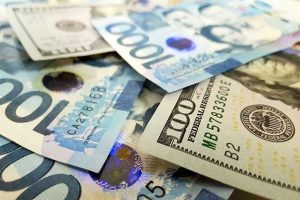
Peso rebounds to P57 level on US recession fears
THE PESO returned to the P57-per-dollar level on Monday, ending at an over two-month high, as weak US data fanned worries about the world’s largest economy.
The local unit closed at P57.90 per dollar on Monday, strengthening by 18 centavos from its P58.08 finish on Friday, Bankers Association of the Philippines data showed.
This was the peso’s first time to close at the P57 level in more than two months or since it ended at P57.97 on May 28. It was also the local currency’s best finish since its P57.62-per-dollar close on May 17.
The peso opened Monday’s session stronger at P57.85 against the dollar. It climbed to as high as P57.68, while its weakest showing was at P57.915 versus the greenback.
Dollars exchanged rose to $1.76 billion on Monday from $1.36 billion on Friday.
The peso strengthened following the weak US jobs report on Friday, a trader said in a phone interview.
The local unit was supported by a weaker dollar following the data, with the yen hitting a seven-month high on Monday, Rizal Commercial Banking Corp. Chief Economist Michael L. Ricafort said in a Viber message.
Japan’s yen hit its highest levels against the dollar since January on Monday, as markets extended moves triggered last week by weak US labor data that stoked recession worries and expectations of deeper rate cuts by the Federal Reserve, Reuters reported.
The carry-funding favorite, the yen, strengthened as much as 3.4% to 141.675 per dollar at one point, before easing to 143.165. The currency was trading near its strongest level since early January.
The dollar dropped 0.5% against major currencies to trade at 102.62 — a near five-month low.
The US unemployment rate jumped to near a three-year high of 4.3% in July amid a significant slowdown in hiring, heightening fears the labor market was deteriorating and potentially making the economy vulnerable to a recession.
The increase in the unemployment rate from 4.1% in June marked the fourth straight monthly increase, the Labor department reported on Friday.
Its rise from a five-decade low of 3.4% in April 2023 to now the highest level since September 2021 all but guarantees a September interest rate cut from the Federal Reserve, with economists calling for a 50-basis-point (bp) reduction in borrowing costs. They argue that the US central bank is most likely behind the curve in easing monetary policy.
Nonfarm payrolls increased by 114,000 jobs last month, the Labor department’s Bureau of Labor Statistics said. That was well below the 215,000 jobs per month added over the last 12 months, and the at least 200,000 that economists say are needed to keep up with growth in the population, accounting for the recent surge in immigration.
Economists polled by Reuters had forecast payrolls would advance by 175,000 jobs. The establishment survey, from which payrolls are counted, also showed the economy created 29,000 fewer jobs in May and June than previously reported.
Fed fund futures reflected traders pricing a near 99% chance of a 50-bp cut at the central bank’s September meeting, according to LSEG data. Futures imply 127 bps of cuts this year.
The peso lost steam towards the end of Monday’s session amid renewed geopolitical worries due to the latest developments in the war in the Middle East, the trader added.
The US military is deploying more forces in the Middle East and Europe following threats from Iran and its allies Hamas and Hezbollah to respond to the killing of Hamas leader Ismail Haniyeh last week in Tehran.
For Tuesday, the trader sees the peso moving between P57.65 and P58.05 per dollar, while Mr. Ricafort sees the peso ranging from P57.75 to P58. — AMCS with Reuters



